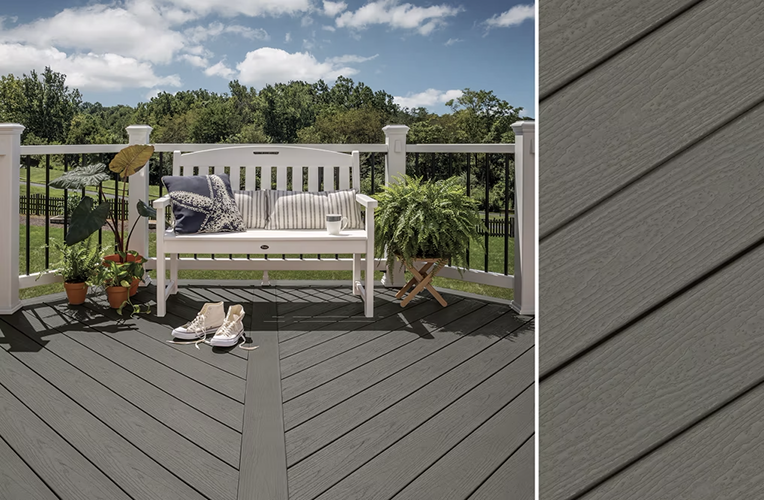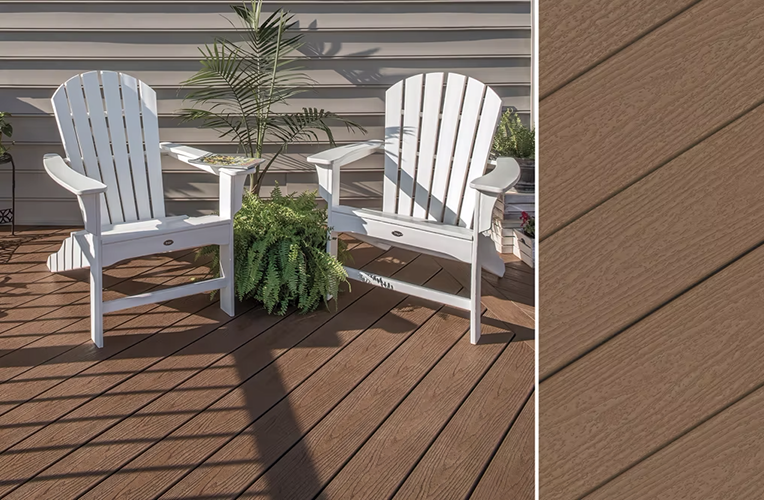Saltwater Corrosion Residue Cleaning for Trex Seaside Composite Decking
Table of Contents
- Key Takeaways
- Why Clean Trex Decking Regularly?
- Spotting Saltwater Damage: Early Detection Tips
- Protecting Your Deck: Preventive Care Strategies
- Follow-Up Care: Ensuring a Clean Deck All Year Round
- Additional Tips and FAQs
- Frequently Asked Questions (FAQ)

Key Takeaways
- Regular cleaning of Trex seaside decking is essential to prevent saltwater corrosion.
- Identify saltwater damage early by looking for signs like discolouration and residue buildup.
- Use specific tools and materials for effective cleaning, such as soft bristle brushes and appropriate cleaners.
- Adopt preventive measures like sealers and routine maintenance to prolong the life of your deck.
- Learn more about protecting your investment and keeping your deck pristine by visiting our comprehensive guide.
Why Clean Trex Decking Regularly?
Maintaining the beauty of your seaside Trex decking isn't just about aesthetics; it's about longevity. Saltwater can be incredibly harsh on any exterior surface, leading to corrosion and residue buildup that not only looks unsightly but can also weaken your deck over time. Therefore, regular cleaning is not just a recommendation; it's a necessity to ensure the durability and safety of your outdoor space.
Saltwater Residue and Its Effects on Decking
Saltwater residue isn't just salt. It's a mix of minerals, organic matter, and other corrosive elements that can eat away at your deck. Over time, this can lead to pitting, cracks, and other structural issues. Besides that, it can create a surface that's slippery and dangerous to walk on. Understanding this is crucial because the longer you wait, the harder it will be to clean and the more damage your deck will sustain.
Tools and Materials Needed for Effective Cleaning
Before we dive into the nitty-gritty of cleaning, let's talk about what you'll need. The right tools make all the difference. You'll want a soft bristle brush to avoid scratching the composite material, a bucket for your cleaning solution, and a garden hose with a nozzle for rinsing. When it comes to cleaning products, choose a cleaner specifically designed for composite decking. Avoid harsh chemicals like bleach that can discolor and damage the deck.
Spotting Saltwater Damage: Early Detection Tips
Early detection of saltwater damage can save you a lot of hassle. Keeping an eye out for the tell-tale signs of corrosion and acting swiftly can prevent minor issues from becoming major headaches.
Example: Last summer, a homeowner noticed some slight discoloration on their Trex deck after a particularly stormy season by the coast. By identifying the issue early, they were able to clean the affected area promptly, preventing further damage and preserving the deck's integrity.
Visual Signs of Saltwater Residue
Look for areas where the colour seems faded or where white, crusty spots have formed. These are clear indicators that saltwater has left its mark. Also, keep an eye out for any signs of metal corrosion around fasteners and fixtures, as this can affect the deck's overall stability.
Tips for Frequent Deck Check-Ups
Make it a habit to inspect your deck regularly, especially after storms or high tides when saltwater spray is most likely to have reached your deck. Check for loose boards or railings, and make sure to clear away any debris that can trap moisture against the deck surface.
Preparation and Pre-Cleaning
Before you start the actual cleaning, remove all furniture, grills, and any other items from your deck. This gives you full access to the surface and ensures you won't miss a spot. Sweep the deck to remove loose dirt, leaves, and debris. This step is crucial because any leftover particles can become abrasive when you start scrubbing.
Detailed Deck Cleaning Methods
Cleaning your Trex seaside decking is a straightforward process, but it requires attention to detail. The goal is to remove the saltwater residue without damaging the composite material.
Hand Washing Techniques
Start by mixing a solution of composite deck cleaner and warm water. Using a soft bristle brush, gently scrub the surface of the deck with the cleaning solution. It's important to work in small sections, rinsing with clean water before the solution dries to prevent streaking. For stubborn spots, apply the cleaner directly and let it sit for a few minutes before scrubbing.
Proper Usage of Power Washers
If you choose to use a power washer, it's essential to use it correctly to avoid damaging your deck. Set it to a low pressure and hold the nozzle about 8-10 inches from the deck's surface. Use a fan tip and spray in a sweeping motion, keeping the nozzle moving to avoid concentrated pressure on one spot. Remember, the goal is to rinse away residue, not blast your decking into submission.
Rinsing and Drying: Final Touches
After thoroughly scrubbing the deck, rinse it with clean water to remove any remaining cleaning solution and loosened residue. Allow the deck to dry completely. If you've cleaned on a hot day, the sun will take care of most of the drying process. If not, you may need to use a squeegee or dry mop to remove excess water, especially from areas where water can pool.
Protecting Your Deck: Preventive Care Strategies
Once your Trex deck is clean, it's time to think about how to keep it that way. Prevention is key when it comes to saltwater corrosion.
Sealers and Coatings: Longevity for Your Deck
- Apply a water-repellent sealer to protect against moisture and salt infiltration.
- Consider anti-corrosive coatings for metal fixtures to prevent rust and degradation.
- Reapply these treatments as recommended by the manufacturer, typically every 1-2 years.
Using the right products will extend the life of your deck and reduce the frequency of deep cleanings.
Proactive Measures to Combat Saltwater Corrosion
Beyond sealers and coatings, there are everyday actions you can take to minimize saltwater damage. Rinse your deck with fresh water after exposure to salt spray, especially following storms. Keep an eye on the forecast and cover your deck before a big storm if possible. And most importantly, address any damage or wear immediately to prevent further issues.
Follow-Up Care: Ensuring a Clean Deck All Year Round
Regular maintenance is the best way to ensure your deck stays clean and in great condition. But what does that look like throughout the year?
Seasonal Maintenance Schedules
At the start of each season, give your deck a quick clean to remove any dirt or debris that's accumulated. This is also a good time to inspect for any potential damage. In the spring, focus on removing pollen and other allergens. In the fall, clear away leaves and twigs to prevent mold and mildew growth.
When to Call in The Professionals
If you're ever in doubt about how to clean your deck or if you notice significant damage, it's time to call in the professionals. They have the tools, knowledge, and experience to handle any issue efficiently and effectively. Remember, investing in professional maintenance can save you money in the long run by preventing costly repairs.
To learn more about keeping your seaside decking in top condition, visit our comprehensive guide on saltwater corrosion residue cleaning for all the details and expert advice you need.
Additional Tips and FAQs
After investing time and effort into cleaning your Trex seaside decking, there are additional tips that can help you maintain its pristine condition. Simple, routine practices can make a significant difference in the longevity and appearance of your deck.
Addressing Stubborn Stains and Blemishes
Stains and blemishes can be a real eyesore on your decking. For grease stains, use a degreaser that's compatible with composite materials. If you're dealing with mildew or mold, a mixture of vinegar and water can be effective. Always test any cleaning solution on a small, inconspicuous area first to ensure it doesn't cause any damage.
What to Avoid: Common Decking Maintenance Missteps
When it comes to maintaining your Trex deck, there are a few common mistakes to avoid:
- Never use harsh chemicals like bleach or chlorine as they can discolour and damage the composite material.
- Avoid using abrasive scrubbers or steel wool, which can scratch the surface.
- Don't ignore the manufacturer's instructions for care and maintenance.
By steering clear of these missteps, you'll keep your deck looking its best.
Frequently Asked Questions (FAQ)
How Often Should I Clean My Trex Seaside Decking?
It's recommended to clean your Trex decking at least twice a year. However, if your deck is exposed to high saltwater spray, you may need to clean it more frequently. After any significant storm, it's wise to give your deck a quick rinse with fresh water.
Can I Use Bleach to Remove Saltwater Residue?
No, you should avoid using bleach on your Trex decking. Bleach can discolor the boards and weaken the composite material. Instead, use cleaners specifically formulated for composite decking or mild soap and water for regular cleaning.
What Is the Best Way to Prevent Saltwater Damage?
The best way to prevent saltwater damage is through regular maintenance and cleaning. Additionally, apply a water-repellent sealer to protect the surface and rinse the deck with fresh water after exposure to salt spray. Proactively managing the deck's exposure to saltwater will help maintain its integrity over time.
Is Pressure Washing Safe for Trex Decking?
Pressure washing is safe for Trex decking if done correctly. Use a low-pressure setting and a fan tip nozzle, keeping it at least 8-10 inches from the surface. Move the nozzle in a sweeping motion to avoid concentrating the pressure in one area, which could damage the decking.
When Should I Seek Professional Maintenance for My Deck?
If you encounter issues such as deep stains, structural damage, or if you're unsure about the proper maintenance techniques, it's best to seek professional help. Deck maintenance experts have the experience and tools necessary to address any problems and can provide guidance on preserving your deck's beauty and safety.
For those looking to dive deeper into the intricacies of maintaining their seaside sanctuary, our comprehensive guide offers all the information you'll need. Learn more about saltwater corrosion residue cleaning for Trex Seaside Decking and ensure your outdoor space remains a source of pride and enjoyment for years to come.
Maintaining your Trex seaside decking is crucial, especially if you live in a coastal area where saltwater corrosion is a common issue. To ensure the longevity and beauty of your deck, it's important to clean the saltwater residue regularly. For best practices on care and cleaning of your Trex deck, you can refer to the official Trex care and cleaning guidelines. Following these guidelines will help protect your investment and keep your deck looking as good as new.


